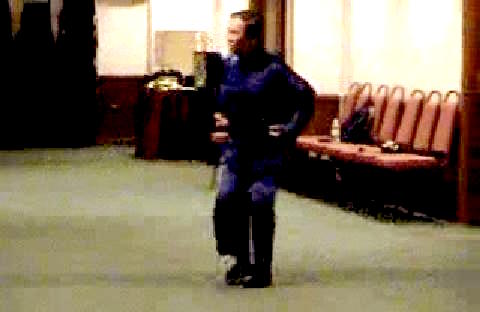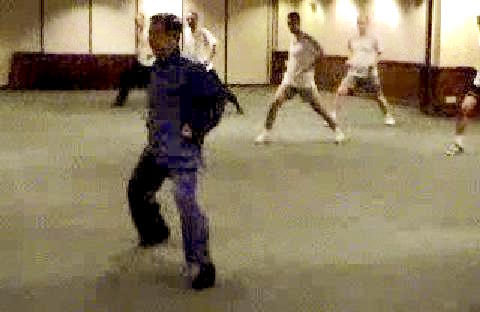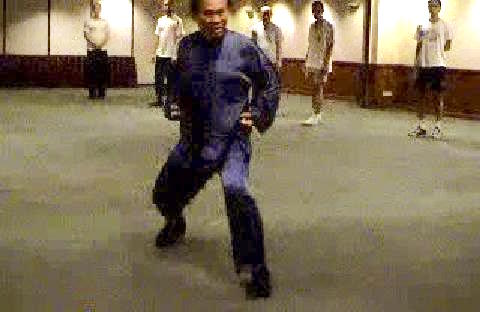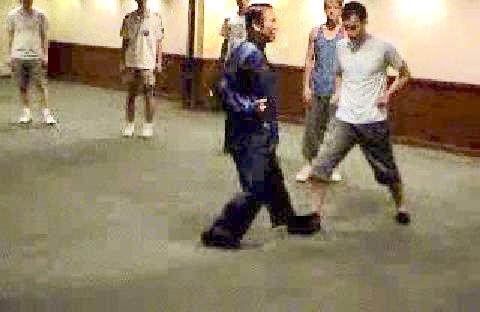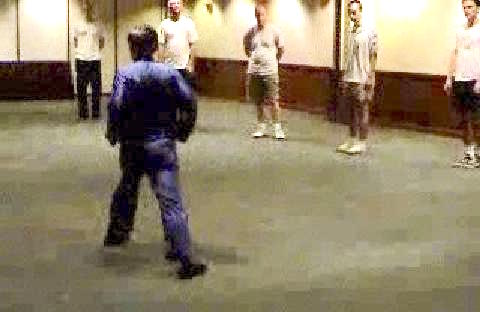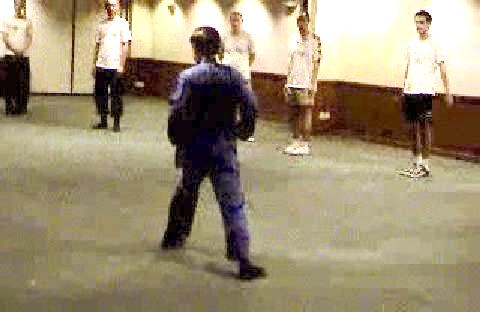MOVING TO VARIOUS DIRECTIONS USING DIFFERENT WAYS TO GAIN ADVANTAGES
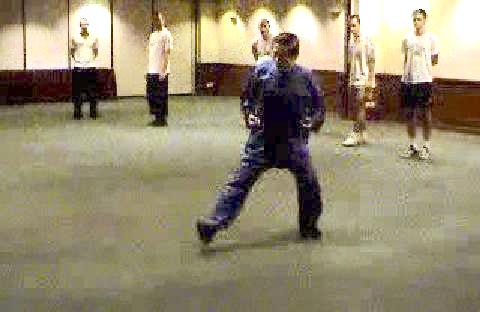 Moving to various directions using various ways
Moving to various directions using various ways
Having learnt the mechanics of movement, like differentiating yin-yang, starting from the back leg, and rotating from the waist, you can move to various directions, formalized into north, south, east, west, north-east, north-west, south-east and south-west.
Just to move into one particular direction, there are many different ways to do so which can give you certain advantages. Reversely, if you do not understand these principles and move randomly, you may place yourself in disadvantageous positions without your opponents doing anything.
You will have a systematic understanding of the various ways of movement if you analyze the various movements into the following factors.
- direction, formalized into north, south, east, west, north-east, north-west, south-east and south-west
- right or left mode
- step forward or roll forward or to any direction
- yin, yang or central approach
- clockwise or anti-clockwise turning
- front-point, mid-point or end-point reference
You need not use all these factors. If you wish to move to north-east, for example, you may start with a left stance or a right stance, step or roll forward into a left stance or a right stance by turning clockwise or anti-clockwise.
Of course you can reduce extraneous movements in roll steps too. If you take away the starting and the ending steps, and just roll along, you may gallop like a horse.
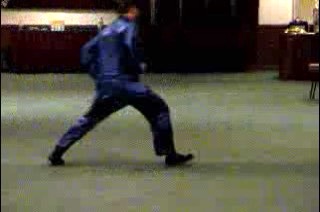 Combining Stepping Forward and Rolling Forward
Combining Stepping Forward and Rolling Forward
By various combinations of stepping and rolling forward, you can have a variety of forward movements to meet particular situations. Many students are not aware of creating technical advantages by choosing a preferred leg-mode.
You can step to the left side using big movements and then small movements. Note that the movement code is right-left, i.e. from right Bow-Arrow Stance to left Bow-Arrow Stance.
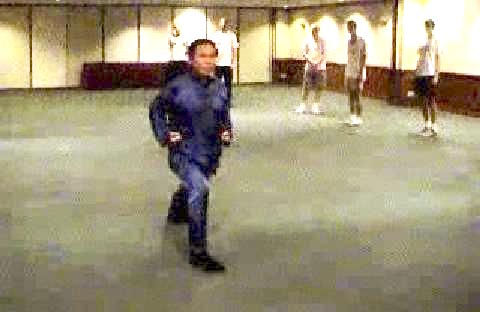 Moving to the Left using Right-Right Mode
Moving to the Left using Right-Right Mode
You are at a right Bow-Arrow Stance. If for some advantageous factors you wish to move to your left side still maintaining your right Bow-Arrow Stance, you can roll to your left. Note that here the point of reference for turning is your front leg.
You can also gain certain technical advantages by moving into your opponent in a yin approach or a yang approach. There is also the central approach (to be shown in the next video clip). These different approaches apply to both stepping or rolling forward or backward.
There are some differences and their resultant advantages in using the yin, yang and central approaches when moving into an opponent.
 Turning in Clockwise or Anti-Clockwise Directions
Turning in Clockwise or Anti-Clockwise Directions
You can turn in the clockwise or anti-clockwise directions. Note that clockwise and anti-clockwise directions are independent of the yin, yang or central approaches. In other words, if you use the yin approach, you may turn in a clockwise direction or an anti-clockwise direction.
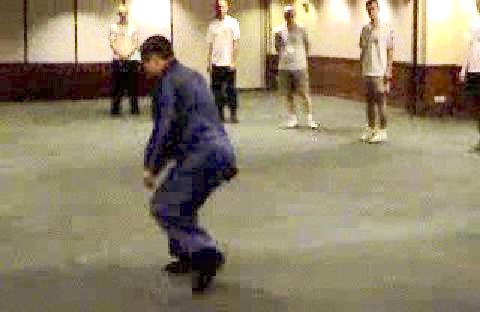 Yin, Yang and Central Approaches in Moving Back
Yin, Yang and Central Approaches in Moving Back
You can use the yin, yang and central approaches in moving back. These different ways of movement may not matter in low level fighting, but in high level fighting a technical advantage gained in such movements may make a big difference.
Moving to the Right Side
Here are a few ways of moving to the right side. The clockwise or anti-clockwise turning of the body and the moving leg is usually the same, but sometimes it may be different. The moving mode is right-left. Do you know how to move right-right?
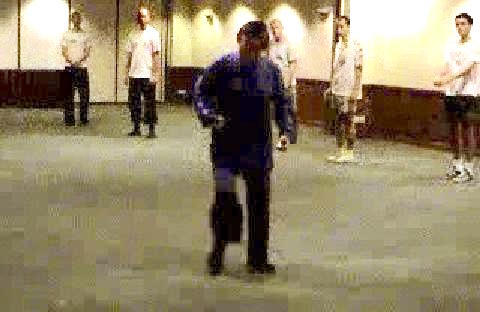 Different Ways of Moving to the Same Direction
Different Ways of Moving to the Same Direction
By choosing different aspects of movement, like left or right mode, step or roll forward, yin or yang approach, clockwise or anti-clockwise turning, you can move to the same direction in different ways. When you have learnt them well, your movements should be fast and spontaneous.
 Securing Advantages with Complex Movements
Securing Advantages with Complex Movements
Why make complex movements when you can turn to the same direction in a simple move requiring less time and effort? There are situations when complex movements are preferred, like when you wish to twist your opponent's limbs with your turning momentum.
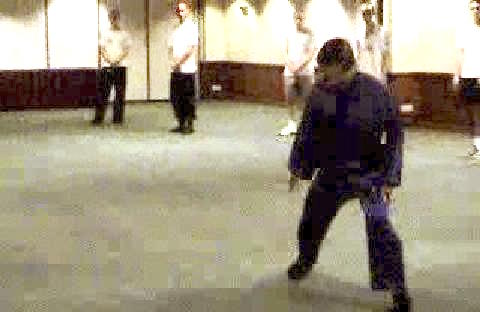 Front Point and Back Point Reference
Front Point and Back Point Reference
Here is another aspect of movement. You can move to your left, or any direction, using your front leg or your back leg as the point of reference.
You can also use a mid-point reference. By varying the factors of movement, you can move to various directions in different ways to gain certain advantages.
Moving into Same Direction Using Different Ways to Gain Advantages from Wong Kiew Kit on Vimeo.
1. Stances: the Foundation for Internal Force and Combat Efficiency
2. Footwork Secrets for Health, Efficiency and Elegance
3. Moving into a Same Direction using Different Ways to Gain Advantages
4. Picture-Perfect Forms and Flowing Movements
5. From Random Fighting to Patterns, and from Patterns to Sequences and Sets
6. One-Step Sparring to Develop Combat Skills
7. From Pre-Arranged Sparring to Guided Sparring
8. Using Techniques and Tactics in Sparring
9. The Five Basic Kicks
10. The Secrets of Side Kicks and Continuous Cannons
11. How You may Defeat Opponents Experienced in Random Free Sparring
12. How Would a Fragile Girl Counter a Powerful Sweeping Kick from a Muay Thai Fighter?
13. Shaolin Felling Techniques and their Defences
14. Safety First Before Executing Felling Techniques
15. From Combat Sequences to Free Sparring
16. Sixteen Combat Sequences and Five Kungfu Sets
17. Surprise your Attacker with a Counter-Attack
18. Working out Ways to Fight a Boxer
19. Effective Tactics and Techniques against Boxers
20. From Gross Outline to Fine Details
21. Exploiting Advantage to Clinch Victory
22. Variety of Kungfu Techniques against Boxers
23. Analysis of Techniques Used against Boxers
24. Using Shaolin Kunfu against Boxing in Free Sparring
25. Effective Shaolin Tactics and Techniques against Kick-Boxing
26. Shaolin Kungfu against Kick-Boxing in Free Sparring
27. How to Handle a Karate Exponent
28. How to Handle a Taekwondo Exponent
29. How to Handle a Wrestling Exponent
30. Understanding the Typical Attacks of Muay Thai Fighters
31. Grandmaster Ho's Secrets in Countering Muay Thai Fighters
32. First Avoid Defeat, Then Secure Victory
33. Counteroing the Elbow and Knee Attacks of Muay Thai Fighters

